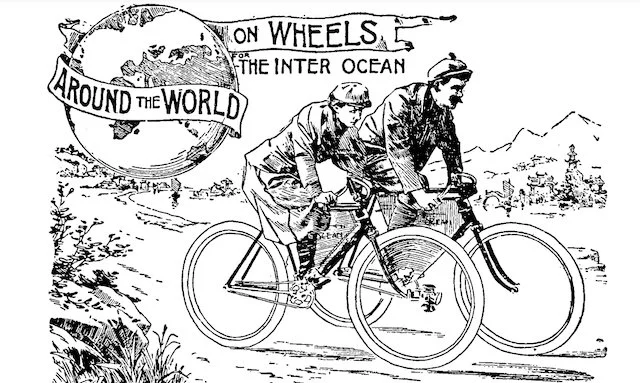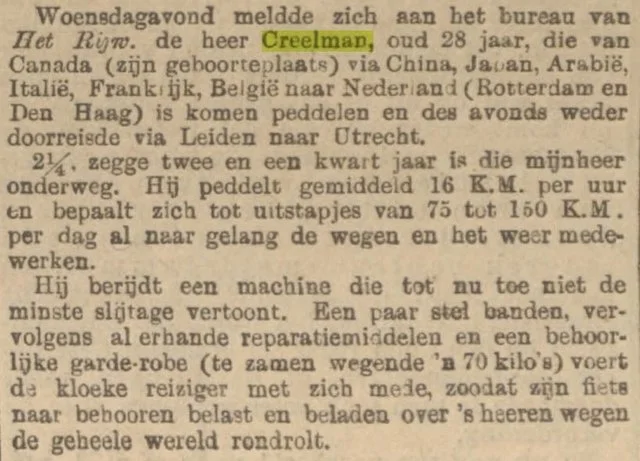When Karl set out to bike around the world, he didn’t have much experience riding a bicycle. Cycling from his hometown of Truro, Nova Scotia, was only his third time riding a bike. At 21, that’s quite old, considering most children learn how to ride a bike as early as five. But this wasn’t unusual in 1899 because not many people had ridden a bicycle in the style we know today. The bicycle was a relatively new invention.
The bicycle evolved dramatically in the 1890s, and the new design had wheels of equal size — as opposed to the penny farthing — with inflatable tires replacing wooden or solid rubber tires. The new bicycle was safer, cheaper and therefore accessible to everyone. It sparked an international craze. Then, two years and two months later, on July 17, 1901, Mr. John MacFarlane, a local Yacht Agent, certified that Karl Creelman had passed on his bicycle through Rotterdam. At which point he had cycled 13,470 miles on his trusty Red Bird.
When Karl arrived in the Netherlands, it wasn’t the Red Bird but Omafiets (aka “Grandma Bicycle” or “Granny-Bike”) that was popular with the wealthy Dutch. The Omafiets are comfortable, upright bicycles that accommodate any ability and all ages. It didn’t take long before the Omafiets became more affordable, and the Dutch started constructing dedicated bike paths for this two-wheeled revolution.
By the time I arrive in Rotterdam 120 years later, the Netherlands has more bicycles than people –– approximately 22 million bicycles for 17 million residents and 32,000 kilometres of bicycle lanes. The volume of cyclists moving seamlessly through a network of trails through the city is a sight to behold.
As a pedestrian, it brings about a new level of awareness of how prolific the bicycle is while attempting to navigate street crossings. You must be mindful of the road rules for both cars and bikes and literally, stay in your lane! The vehicle traffic seems inconsequential compared to the hundreds of bikes zooming along at speeds now accelerated with the advent of the e-bike on their dedicated paths.
These cyclists aren’t the aerodynamic helmet, spandex-wearing, water bottles inserted into shirt pockets and cycling as if in preparation for the next tour de France types of bikers. They are individuals travelling efficiently to get groceries or meet friends. They may be corporate professionals dressed smartly in practical shoes on their pedals and accompanying office shoes packed in their stylish bike pannier. Or parents on accessorized bikes with attachments to carry a child to drop-off at daycare. The bicycle may be ridden for the entire travel distance or a partial journey to a neighbouring bus or train station.
When Karl travelled around the world on his bicycle in 1899, it was simply the most practical and feasible way that he could travel. But in the Netherlands, this continues to be the trend. Riding a bicycle is an expeditious way to travel, environmentally responsible and economical. Certainly, if Karl travelled on his bike today, he would have marvelled at the number and style of bicycles, particularly the e-bike. Imagine, dear reader, how that could have helped Karl as he travelled up hills, over rail tracks, and in poor weather.
It would seem Karl’s perseverance was the only source of energy needed to fuel the Red Bird. On July 25, 1901, the following article appeared in the edition of the Algemeen Handelsblad (General Trade Magazine): On Wednesday, it was reported to the Office that Mr Creelman, aged 28 years, who left Canada (his birthplace) via China, Japan, Arabia, Italy, France, Belgium to the Netherlands (Rotterdam and The Hague) came pedalling, and again in the evening he travelled on via Leiden to Utrecht. It’s been two and a quarter years that he has been en route. He peddles an average of 16km per hour and decides on trips from 75 to 150km every day, depending on the roads and weather. He rides a machine that, until now, shows minimal wear. A pair of tires, according to all available repair means and an appropriate wardrobe (weighing a total of 70 kilos) carries the wise traveller with him. His bicycle is duly loaded to bear the burden of the Gentleman as he rides around the world.
In case you’ve missed them, click here for more Karl Chronicles


